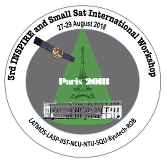Conveners
Session 2: Results from recent space missions
- Mustapha Meftah (LATMOS / CNRS / Paris-Saclay University)
Session 2: Results from recent space missions
- Mustapha Meftah (LATMOS / CNRS / Paris-Saclay University)
Marie Dominique
(ROB)
28/08/2018, 11:00
Session 2: Results from recent space missions
talk
PROBA2 is an ESA micro-sat that hosts two solar instruments: SWAP, an EUV telescope, and LYRA, a radiometer observing the Sun in four bandpasses spanning the XUV to MUV range. LYRA primary objectives are the monitoring of solar activity for space weather purposes and the analysis of solar flares, but it has also been used in other specific contexts such as the determination of O+N2 densities...
Dr
Laurence Wauters
(ROB)
28/08/2018, 11:20
Session 2: Results from recent space missions
talk
The periodograms of the PROBA2/LYRA data show predominant periodicities comparable to the ones observed by other solar time series for the same time range. These periodicities have been found to slightly vary over time.
Tracking their evolution on a long-term basis aims at identifying which periodicities are related to each other and at determining which physical processes are at their...
Dr
David Bolsée
(BIRA-IASB)
28/08/2018, 11:40
Session 2: Results from recent space missions
talk
The SOLAR/SOLSPEC instrument, installed on the SOLAR payload on board the International Space Station, has performed between 2008 and 2017 Solar Spectral Irradiance (SSI) measurements from the UV to the NIR. It was an upgrade version of SOLSPEC launched in the 80’s and 90’s for SPACELAB, ATLAS, and EURECA missions. We will present the highlights of the 9-year SOLAR mission. The requirements...
Mr
Nuno José Pereira
(BIRA-IASB)
28/08/2018, 12:00
Session 2: Results from recent space missions
talk
The near infrared (NIR) part of the solar spectrum is of prime importance for the solar physics and climatology, directly intervening in the Earth's radiation budget. Despite its major role, available solar spectral irradiance (SSI) NIR datasets, space-borne or ground based, present discrepancies caused by instrumental or methodological reasons.
We present new results obtained from the...
Dr
Luc Damé
(LATMOS/IPSL/CNRS/UVSQ)
28/08/2018, 12:20
Session 2: Results from recent space missions
talk
Accurate measurements of solar spectral irradiance (SSI) and its temporal variation are of primary interest to better understand solar mechanisms and the links between solar variability and Earth’s atmosphere and climate. We present recent ultraviolet (UV) SSI observations performed by the SOLAR/SOLSPEC spectrometer on board the International Space Station. SOLAR/SOLSPEC observations cover the...
Dr
Athanassios Katsiyannis
(Royal Observatory of Belgium)
28/08/2018, 14:00
Session 2: Results from recent space missions
talk
We present the analysis of energetic particles, indirectly detected by the Large Yield RAdiometer (LYRA) instrument on board ESA's Project for On-board Autonomy 2 (PROBA2) satellite in the form of microbursts of <10 ms, with a phenomenon duration of 100 s. Combining Energetic Particle Telescope (EPT/PROBA-V) observations with LYRA data for an overlapping period of time, we identified these...
Dr
Rémi Thieblemont
(CNRS)
28/08/2018, 14:20
Session 2: Results from recent space missions
talk
Solar spectral irradiance fluctuations associated with the Sun’s 27-day rotational cycle can significantly influence ozone variability in the tropical middle atmosphere. In the stratosphere, previous observational studies based on different instruments and time periods revealed however large disparities in the magnitude of the ozone response to the 27-day solar signal. For the mesosphere, only...
Dr
Vincent Lapeyrere
(LESIA, Observatoire de Paris, Université PSL, CNRS, Sorbonne Université, Univ. Paris Diderot, Sorbonne Paris Cité)
28/08/2018, 14:40
Session 2: Results from recent space missions
talk
PicSat was a three unit CubeSat (measuring 30 cm × 10 cm × 10 cm) which was developed to monitor the β Pictoris system. The main science objective was the detection of a possible transit of the giant planet β Pictoris b’s Hill sphere. Secondary objectives included studying the circumstellar disk, and detecting exocomets in the visible band. The mission also had a technical objective:...

